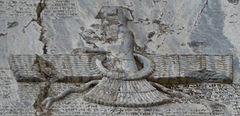Anushtegin dynasty

 |
| History of Greater Iran |
|---|
The Khwarezmian Empire, more commonly known as the empire of the Khwarezm Shahs[1] (Template:PerB, Khwārezmšhāḥīān, "Kings of Khwarezmia") was a Persianate[2][3][4] Sunni Muslim dynasty of Turkic mamluk[5] origin which ruled Greater Iran, first as vassals of the Seljuqs and later as independent rulers in the 11th century. The empire survived until the Mongol invasion in 1220.[1] The dynasty was founded by Anūsh Tigin Gharchāī, a former slave of the Seljuq sultans, who was appointed the governor of Khwarezm.[1] His son, Qutb ud-Dīn Muhammad I, became the first hereditary Shah of Khwarezm.
History
The date of the founding of the empire is uncertain. Khwarezm was a province of the Ghaznavid Empire from 992 to 1041. In 1077 the governorship of the province, which now belonged to the Seljuqs, fell into the hands of Anūsh Tigin Gharchāī, a former Turkic slave of the Seljuq sultan. In 1141, the Seljuq Sultan Ahmed Sanjar was defeated by the Kara Khitay (Kara-Khitan Khanate) and Anūsh Tigin's grandson Ala ad-Din Aziz was forced to submit as a vassal to the Kara Khitay.
Sultan Ahmed Sanjar was killed in 1156: when the Seljuk state fell into chaos, the Khwarezms expanded their territories southward. In 1194, the last Sultan of Great Seljuq state, Toğrül III, was defeated and killed by the Khwarezm ruler Ala ad-Din Tekish who also freed himself of the Kara Khitay. In 1200, Tekish died and was succeeded by his son, Ala ad-Din Muhammad, who by 1205 had conquered all of Great Seljuq and declared himself Shah (Persian for king) - he became known as the Kwarezmshah. In 1212 he defeated the Gur-Khan Kutluk and conquered the lands of the Kara Khitay, now ruling a territory from the Syr Darya almost all the way to Baghdad, and from the Indus River to the Caspian Sea.
In 1218, Genghis Khan sent some emissaries to the Shah, but when he executed the Mongol diplomats in defiance of the emerging great power, Genghis retaliated with a force of 200,000 men. In February 1220 the Mongolian army crossed the Syr Darya and launched the Mongol invasion of Central Asia. The Mongols stormed Bukhara, Samarkand, and the Khwarezmid capital Urgench. The Shah fled and died some weeks later on an island in the Caspian Sea.

In Great Captains Unveiled of 1927, B.H. Liddell Hart gave details of the Mongol campaign against Khwarezm, underscoring his own philosophy of "the indirect approach," and highlighting many of the tactics used by Genghis which were to be subsequently included in the German Blitzkrieg tactics, inspired in part by Liddell Hart's writings.
The son of Ala ad-Din Muhammad, Jalal ad-Din Manguberdi became the new Sultan (he rejected the title Shah) but he had to flee to India. However, the Mongols caught up with him before he got there, and he was defeated at the Battle of Indus. He and his closest followers then fled to Armenia where they attacked the Seljuk Sultanate of Rûm. He had a brief victory capturing the town Ahlat, but was later defeated by Sultan Kayqubad I at the Battle of Yassi Chemen in 1230, and murdered in 1231 by a Kurdish assassin.[6]
Mercenaries
Though the Mongols had destroyed the Khwarezmian Empire in 1220, many Khwarezmians survived by working as mercenaries in northern Iraq. Manguberdi's followers remained loyal to him even after his death in 1231, and raided the Seljuk lands of Jazira and Syria for the next several years, calling themselves the Khwarezmiyyas. Ayyubid Sultan Salih Ayyub, in Egypt, later hired their services against his uncle Salih Ismail. The Khwarezmiyyas, heading south from Iraq towards Egypt, invaded Christian-held Jerusalem along the way, on July 11, 1244. The city's citadel, the Tower of David, surrendered on August 23. This triggered a call from Europe for the Seventh Crusade, but the Crusaders would never again be successful in retaking Jerusalem. After being conquered by the Khwarezmian forces, the city stayed under Muslim control until 1917, when it was taken from the Ottomans by the British.
After taking Jerusalem, the Khwarezmian forces continued south, and on October 17 fought on the side of the Egyptians at the Battle of Harbiyah, northeast of Gaza, killing the remains of the Christian army there, some 1,200 knights. It was the largest battle since the Battle of the Horns of Hattin in 1187.[7]
The remains of the Muslim Khwarezmians served in Egypt as Mamluk mercenaries until they were finally beaten by Mansur Ibrahim some years later.
Rulers of Khwarezm
Ma'munids
Altuntashids
Non-dynastic
Anushtiginids
Non-dynastic
Anushtiginids
- Qutb ad-Din Muhammad I 1097-1127
- Ala ad-Din Aziz 1127-1156
- Il-Arslan 1156-1172
- Sultan Shah 1172-1193
- Ala ad-Din Tekish 1172-1200
- Ala ad-Din Muhammad II 1200-1220
- Jalal ad-Din Mingburnu 1220-1231
See also
Literature
- M. Ismail Marcinkowski, Persian Historiography and Geography: Bertold Spuler on Major Works Produced in Iran, the Caucasus, Central Asia, India and Early Ottoman Turkey, with a foreword by Professor Clifford Edmund Bosworth, member of the British Academy, Singapore: Pustaka Nasional, 2003, ISBN 9971-77-488-7.
Notes and references
- ^ a b c Encyclopaedia Britannica, "Khwarezm-Shah-Dynasty", (LINK)
- ^ Bosworth in Camb. Hist. of Iran, Vol. V, pp. 66 & 93
- ^ B.G. Gafurov & D. Kaushik, "Central Asia: Pre-Historic to Pre-Modern Times"; Delhi, 2005; ISBN 8175412461
- ^ M.A. Amir-Moezzi, "Shahrbanu", Encyclopaedia Iranica, Online Edition, (LINK): "... here one might bear in mind that non-Persian dynasties such as the Ghaznavids, Saljuqs and Ilkhanids were rapidly to adopt the Persian language and have their origins traced back to the ancient kings of Persia rather than to Turkish heroes or Muslim saints ..."
- ^ C.E. Bosworth "Anuštigin Ĝarčāī", Encyclopaedia Iranica (reference to Turkish scholar Kafesoğlu), v, p. 140, Online Edition, (LINK)
- ^ http://persian.packhum.org/persian/pf?file=90001012&ct=107&rqs=68&rqs=491&rqs=893
- ^ Riley-Smith The Crusades, p. 191
